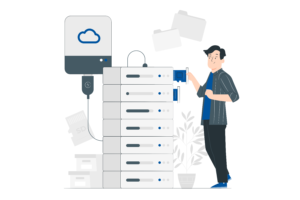
Source: Freepik
Backing up important professional or private files, such as texts, images and other documents, is essential. Data loss can have catastrophic consequences, whether caused by technical mishaps, accidental deletion or even hardware theft. Data loss can also be caused by viruses or hacker attacks. Viruses can, for example, encrypt the hard drive and then demand a ransom. Here are some proven strategies and tools to ensure that your data always remains safe and accessible. You can also take a look at the category IT-Security on our website to find out more tips.
Why Are Backup Routines Important?
The importance of backup routines lies in prevention. Data loss can occur at any time and without warning. A well-designed backup system not only protects you from data loss, but also gives you the security of being able to access the latest version of your work at any time. An effective backup routine should include regular backups, easy restoration and redundancy of storage locations. Here are the steps to set up such a routine:
Regularity Is Crucial
- Daily backups: Back up your data daily, preferably at a time when you are not working on your data.
- Automated backups: Use tools that perform automatic backups. This means you don’t have to think about it yourself every time.
Use both local and cloud-based storage solutions to ensure that your data is backed up multiple times.
Backup Methods
Here are some tools that are suitable for backing up personal data, for example with regard to your studies:
sciebo
sciebo is a cloud storage service designed specifically for universities. It offers a secure way to store and share academic data. The benefits include high data protection standards, large storage capacity and a simple user interface. In addition, sciebo is GDPR compliant. Register with your university account and use the web client or desktop application to upload and synchronise files.
Other cloud storage services
A key advantage of cloud storage is its reliability and independence from your own hardware. Even in the event of hardware loss, for example due to fire or theft, your data remains securely stored in the cloud. However, the use of cloud services also harbours risks, such as possible access by third parties in the event of a hacked account. To prevent this risk, it is advisable to encrypt the data yourself before uploading it to the cloud. One tried-and-tested method is to use software such as Cryptomator, which creates encrypted file containers. These containers reliably protect your data. Keep your key safe, because without it, the encrypted data is no longer accessible. Cryptomator is available free of charge for Windows, macOS and Linux; there are paid versions for mobile devices (Android/iOS) that offer additional functions such as biometric unlocking.
External hard drive
An external hard drive or USB stick is a simple and effective method of creating local backups. Both offer the advantage of large storage capacity, fast data backup and do not require an internet connection. Connect the storage medium to your computer and regularly copy your current files to it. Create folders with dates to back up different versions of the files. As a USB stick or external hard drive can quickly disappear or be stolen, you also have the option of storing an encrypted container.
Types of Data Backup
There are various approaches to data backup to ensure that your data is reliably protected. The three most common methods are
- Full data backup: With this method, a complete copy of all selected files and folders is created each time. This ensures that you always have a complete version of your data, but can take up a lot of storage space and time.
- Incremental data backup: Here, only the files that have been changed since the last data backup (whether full or incremental) are backed up. This method saves storage space and time, but requires a complete backup chain to restore data in the event of a loss.
- Differential backup: This is similar to incremental backup, but instead of just the last change, all changes since the last full backup are backed up. This offers a faster restore than the incremental backup, but requires more storage space than the incremental backup.
Best Practices for Data Backup
- Version control: Regularly save new versions of your files so that you can fall back on older versions in an emergency.
- Checks: Regularly test whether the backups have been created successfully and whether you can restore the data without any problems.
- Security: Make sure that your backup solutions are password-protected and encrypted to prevent unauthorised access.
Backing up your data is essential to prevent data loss. With the right tools and a well thought-out backup routine, you can ensure that your data is protected at all times. Utilise the options available to you and protect yourself and your valuable work from unexpected losses.
Responsible for the content of this article is Malak Mostafa.





Leave a Reply